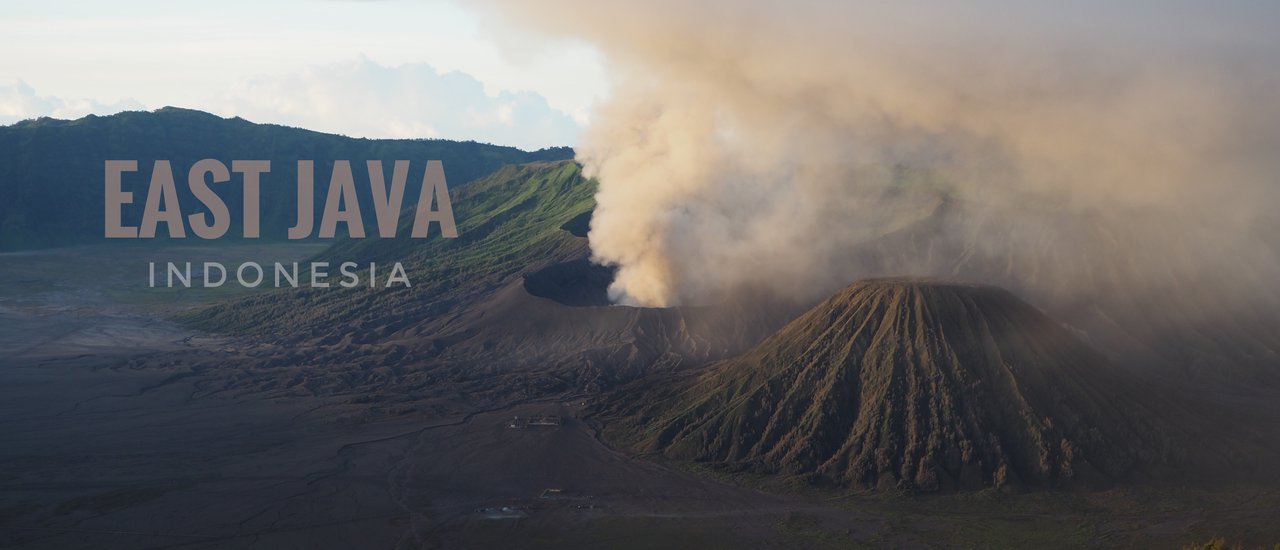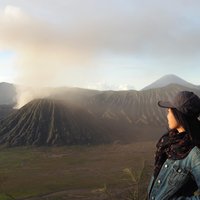A visit to the volcanoes of East Java in Indonesia is a dream trip for many. The majestic Mount Bromo, with its constant eruptions and plumes of smoke, the surrounding volcanoes, and the white sea of fog that blankets the area create a breathtaking scene from any angle. Mount Kawah Ijen offers a unique combination of natural wonders, including the world's largest blue flame area, the world's largest and highest acid lake, and one of the world's largest volcanic craters. These factors made our decision to visit an easy one.
The Ring of Fire, a horseshoe-shaped zone in the Pacific Ocean, is characterized by frequent earthquakes and volcanic eruptions. Spanning approximately 40,000 kilometers, it follows the contours of deep-ocean trenches, volcanic chains, and tectonic plate boundaries. Within this ring, 452 volcanoes reside, representing over 75% of the world's active volcanoes. Mount Bromo and Kawah Ijen are prominent examples of volcanoes located within the Ring of Fire.
This trip took place in Indonesia between April 18th and 26th, 2016. The journey was divided into two islands, starting with the island of Java, where we spent 3-4 days exploring Mount Bromo, Madakaripura Waterfall, and Mount Kawah Ijen. To avoid exhaustion, we decided to dedicate a separate blog post to the island of Bali. Flights to and from Surabaya are available from Bangkok, but for this trip, we flew into Surabaya, spent four days exploring Java, took a one-hour ferry ride to Bali, spent five days there, and then flew back to Thailand from Denpasar Airport in Bali.
When traveling in Java, renting a car with a driver is the most convenient and suitable option for sightseeing. We contacted and negotiated with four companies via email about a month in advance. After comparing prices and conditions, we decided to use Tommy's service because it offered the best price. They charge per person, which is different from other companies. Their email responses were clear and prompt. We started our trip with Tommy from the moment we landed in Surabaya. We visited Bromo-Tengger-Semeru National Park for four days (we used another company in Bali). The cost depends on the number of people in your group. For groups of 2-6 people (which fits in one car), the cost is around 6,000-10,000 baht per person. This includes fuel, driver, jeep for climbing mountains, entrance fees, local guide fees, accommodation for 3 nights + breakfast. **Excluding** other meals, horseback riding (270 baht), and gas masks at Kawah Ijen (135 baht). You can contact Tommy at Email: [email protected].
Thai tourists can visit and stay in Indonesia for 30 days without a visa. The currency used is the Indonesian Rupiah (IDR). As of April 2016, the exchange rate was approximately IDR1,000 = THB2.70.
Let's go!
Day 1: Don Mueang - Surabaya
This sentence describes the first day of a trip from Don Mueang Airport in Bangkok to Surabaya, Indonesia. The original text states that the flight used to be a direct 4-hour journey with AirAsia for around 3,400 baht. However, as of the current date, direct flights are no longer available, and travelers must now connect through another airport, increasing the travel time to 8-16 hours. Several low-cost airlines offer connecting flights, including AirAsia, Tigerair, and Scoot.

Upon arriving in Surabaya, "Iwan," the driver sent by Tommy, was waiting with a sign. The journey continued to Probolinggo, the gateway to Mount Bromo, which took approximately 3-4 hours depending on traffic and the driver's speed. After checking into the hotel, it was time to rest, as the wake-up call was scheduled for 2:30 AM.

Day 2 We met Iwan at 3:00 AM and switched to a jeep. The journey took about 45 minutes to Penanjakan Mountain to watch the sunrise. It was very cold, so be sure to bring warm clothes. We arrived early, around 4:00 AM, and had to wait in the dark and cold for almost 2 hours for the sunrise. At first, I wondered why we had to come so early, but when we arrived, I saw that many tourists were already waiting.
Judging from everyone's outfits, can you guess how cold it is? ^^"

Waking up to watch the sunrise was the earliest I've ever been awake in my life. But what made me even more excited than seeing the beautiful sunrise was waiting for the light to reveal the real Mount Bromo, not just the pictures I'd been searching for online all this time.

The Breathtaking View of Mount Bromo
As the sky began to lighten, the sight that unfolded before us was breathtaking. The group of volcanoes, including Mount Bromo spewing smoke, made us forget the cold, drowsiness, and fatigue from the long journey. Turning to my friend, I exclaimed, "Wow, it's so beautiful!" We both agreed that it was the best decision to abandon our tickets to Bali and purchase new ones to Surabaya. Even though we were only two people and the car rental was expensive, we didn't regret spending the money at all.
This is one of the most famous natural wonders of East Java. ;)

Mount Bromo is located in the Bromo Tengger Semeru National Park in East Java, Indonesia. It stands at 2,329 meters tall and is known as the "Breath of God" due to its sacred status in Hinduism.

View of Cemoro Lawang village from our hotel.

After enjoying the view from Mount Penanjakan, on the way down, there is another spot where the driver will stop for you to take pictures. You will get a view like this.

Mount Batok, located in front of Mount Bromo, is an extinct volcano.

Today, we didn't see the full sea of mist as we had hoped, but that's okay. Even so, it's still incredibly beautiful. ^^

Another important volcano is Mount Semeru, the most sacred volcano according to Hindu beliefs, which is considered the center of the universe and the highest volcano on the island of Java. It has a distinctive, steep, and beautifully proportioned mountain shape. Every 15-20 minutes, Mount Semeru erupts, sending plumes of smoke into the sky as if a natural time bomb were hidden there. At first, when I heard the sound... boom... faintly in the distance, I was a little startled because I had never heard it before. I looked at Iwan with a puzzled expression, and he explained that it was normal, but it was an exciting experience for us.

After descending from the viewpoint, the jeep will park at the foot of the mountain below. We can either walk or ride a horse. At that time, we chose to ride a horse because we wanted to try it, and the distance seemed quite far for us who had been traveling all day and night and had only slept for an hour. We were secretly exhausted, so we had to rely on the horse to take us there. The standard price for a round trip is between 50,000 and 100,000 rupees... don't let it be more expensive than this! ^^"

The horse will take you to the foot of the mountain, and then you will need to climb the stairs yourself.

The air is thick with sulfur dust, falling like rain and filling eyes and noses. It's a good idea to cover your face with a cloth.

Mount Batok up close.

As we ascended, the Hindu temple we had passed on horseback came into view. In the distance, a convoy of jeeps, a herd of horses, a vista of black sulfur dust, and the Penanjakan mountain range, from which we had descended earlier that morning, were visible.

It didn't take long to reach the crater rim of Mount Bromo. The sight was both awe-inspiring and slightly terrifying for someone with a fear of heights. The volcano, aptly nicknamed "The Breath of the Gods," roared with a constant rumble, spewing plumes of smoke that varied in intensity. The smell and dust of sulfur were much stronger than during the ascent. We didn't stay long at the rim due to the fumes, but some braver souls ventured around the crater. However, extreme caution is advised as the concrete barrier is minimal. A Singaporean tourist tragically fell to their death after venturing beyond the designated area.
At the crater rim, local villagers sell flowers to tourists who can make wishes, pray, and pay respects to the gods. After making their wishes, they throw the flowers into the volcano's crater.

On the way down, around 8:00 AM, the sun was out, warming the air.


After descending Mount Bromo, we took a jeep to the Savanna grasslands.


Our trip ended around 9 am, just in time for breakfast and some much-needed rest after a long day and night of travel. Here's a picture from the front of our hotel. ^^

Day 3
Woke up at 6:00 AM, showered, had breakfast, packed our bags, and checked out. We started our journey at 8:30 AM to Madakaripura Waterfall, which took about an hour.
The view along the way is breathtaking.



A five-minute motorbike ride is required to reach the waterfall entrance.

After getting off the motorbike, continue on foot. A local guide will be there to lead the way.


Before reaching this point, make sure to put on your raincoats. You will definitely get wet, very wet, as we have to walk under a curtain of water to get inside. Cameras and phones will be soaked with water droplets.


The Madakaripura Waterfall: A Hidden Gem in a Deep Ravine
The Madakaripura Waterfall, cascading approximately 200 meters down a steep ravine, is a hidden gem nestled amidst lush greenery. Its source lies in the dense forests above, creating a breathtaking natural spectacle. The surrounding environment is particularly noteworthy for its pristine beauty.

Without the guidance of a local guide, reaching this viewpoint would have been difficult. The steep and rocky terrain would have been too daunting to navigate alone.

Along the way to the waterfall, you will be greeted by a large number of monkeys.

Note: The original text is empty, so the translation is also empty.
Following our visit to Madakaripura Waterfall, we embarked on a six-hour journey (including a lunch break) to Bondowoso, a town situated near the easternmost tip of Java. Upon arrival at our accommodation, Catimor Homestay, arranged by Tommy, we rested in preparation for our 00:30 wake-up call to ascend Mount Kawah Ijen.
Day 4
Waking up at 00:30, we barely slept a wink. After checking out, the hotel provided us with a breakfast box. We set off at 1:00 AM and arrived at the Paltuding trailhead, the starting point for the trek to Mount Kawah Ijen, after about an hour. Local guides led the way as we embarked on a 3 km uphill hike in the dark. The steep terrain made the journey challenging, taking us 2 hours to complete. Along the way, we encountered vendors selling refreshments and renting gas masks to protect against the sulfur fumes.
To protect ourselves from the intense sulfur gas, we had to wear masks like this. The masks we bought in Thailand for a few hundred baht, which claimed to protect against odor, dust, smoke, and chemicals with some kind of ventilation valve, were completely useless, according to our guide.

The Blue Flame: A Unique and Hazardous Spectacle
This section highlights the trip's most remarkable feature: witnessing the Blue Flame, a phenomenon found only in two locations worldwide. This blue flame results from burning sulfur, creating a thick, acrid smoke that stings the eyes and nose. Despite the discomfort, our adventurous guide led us down to the point where miners were actively working, a location inaccessible to most tourists due to the intense gas fumes.
The Blue Flame is only visible in complete darkness, disappearing with the first light of dawn. This is why we had to wake up at 1 AM to witness this spectacle.

Capturing the Blue Flame: A Close Encounter
Photographing the Blue Flame presents a significant challenge due to the constant presence of white smoke and the considerable viewing distance. However, our guide bravely volunteered to capture a close-up shot of the Blue Flame. Initially, the guide provided no explanation, simply requesting our camera before disappearing. To our surprise, they reappeared directly next to the Blue Flame! This unexpected maneuver was quite impressive, as no one else had managed to reach that location. Had we been informed beforehand, we would have gladly joined them!
And we got the perfect Blue Flame shot thanks to our lovely, albeit mischievous, guide. ^^

There was also a giant lump of sulfur on display along the way. It was truly enormous.

After descending to admire the Blue Flame, the pungent smell of sulfur gas became unbearable, prompting us to climb back up to the crater rim to enjoy the breathtaking views. A sign warns visitors of the dangers posed by toxic gases.


The violent eruption of the volcano in the past caused the crater to collapse, forming a lake. Standing here looking at the strange and beautiful landscape, I can't help but think that it doesn't seem like the human world at all.

Gazing down from where we had just climbed, we saw the yellow sulfur deposits contrasting with the turquoise color of the lake and the white sulfur smoke billowing. The clear sky without fog allowed us to clearly see the beauty of the place. It is one of the places that impressed us the most, and the Kawah Ijen volcano is still considered an active volcano with the potential to erupt.

The Local Hero: Antun, Our Caring Guide
Our protagonist for the day was Antun, a cheerful local guide who took great care of us, engaging us in conversation and sharing interesting stories throughout the journey. We had run out of money, having only exchanged enough for our initial stay on Java, planning to exchange more in Bali later. This left us short for the mask rental fee, but Antun generously took care of it. He even held our hands while we descended to see the Blue Flame, shining his flashlight for us. He also helped us climb to capture stunning photos of the Blue Flame. Despite not having any tip to offer, he kindly covered the mask fee for us. (However, the guide fee was already included in Tommy's package.)
If you need a guide, I highly recommend this one.


The guide explained that the yellow sulfur lumps are used to produce souvenirs and cosmetics.

We arrived after Songkran, and there were very few tourists. However, during Songkran, the guide was surprised to see around 600 Thai people visiting the site in a single day!

The provided text is empty. Please provide the text you want me to translate.



As we make our way back, the sky will be bright, revealing three more volcanoes surrounding Kawa Ijen. These volcanoes are dormant, and to the left, you can also see the island of Bali.

After concluding our adventure in East Java, we boarded a boat for a one-hour journey to Bali. Exhausted from our climb and reeking of sulfur from head to toe, we were eager to spend the next five days exploring the island.
The experience of visiting the island of Bali is vastly different from that of the island of Java, almost as if they were two separate countries. I will create a separate blog post on this topic. However, if you are not continuing on to Bali after completing this itinerary, you can take a flight back to Thailand from Surabaya, which takes approximately 8 hours.
Tips for Your Trip to Bromo and Kawah Ijen:
1. Flight Timing: Aim to arrive in Surabaya around midday to allow for rest and avoid excessive fatigue.
2. Masks: Masks purchased in Thailand are sufficient for dust protection at Bromo. However, for Kawah Ijen, consider renting a larger mask for enhanced protection.
3. Weather and Clothing: Check the weather forecast before your trip and pack appropriate cold-weather gear. Temperatures near the volcanoes, especially before sunrise and at night, can drop below 10 degrees Celsius.
4. Footwear: The paths leading up and down the crater rim at Kawah Ijen are very steep. Choose appropriate footwear for safe and comfortable hiking.
5. Travel Itinerary: If you're not planning to visit Bali, consider starting your trip at Kawah Ijen and then visiting Bromo, which is closer to the airport, depending on your flight schedule.
This trip was incredibly convenient, easy to navigate, and affordable (especially when traveling with a group) thanks to Tommy's meticulous planning. However, maintaining physical fitness and taking precautions against the extreme cold were crucial. Overall, this was an unforgettable and truly remarkable travel experience.
Follow the travel review information and talk to the author at...
Fanpage: Mytravelholicdiary
Instagram: https://www.instagram.com/my_travelholic_diary/
My Travelholic Diary
Friday, September 27, 2024 10:25 AM
















